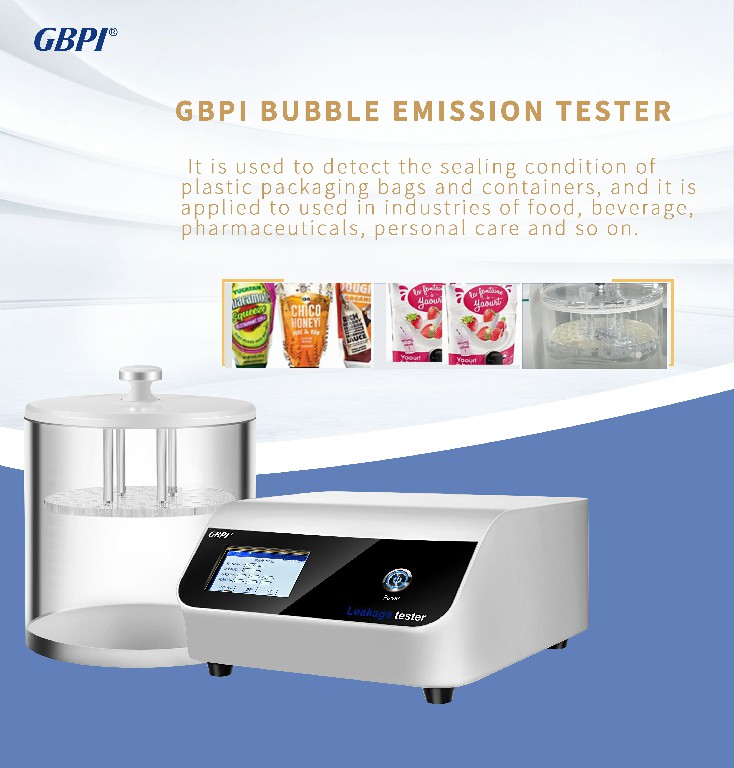Instruments applicable to this standard : GBPI Bubble Emission Tester
Instrument Application Process
The Bubble Emission Test is based on the ASTM D3078 test standard and performs a simple package leak detection test through the physical principle of pressure difference. The most common test method for the food industry, pharmaceuticals, and consumer products
We need to fill the vacuum tank with water to create a sealed environment and then immerse the test sample in the water. The vacuum is completed by pumping the sample into the vacuum tank, creating a pressure differential in the sealed space. We can visually observe if there are bubbles around the sample, and if there are bubbles, the package is damaged or defective.
The Bubble Emission Test is an ASTM D3078 test standard that performs a simple package leak detection test through the physical principle of differential pressure. It is the most commonly used test in the food industry, but is also applicable to the medical, pharmaceutical and consumer goods industries.
The Bubble Emission Test uses a water-filled vacuum tank to create a visual identification of package seal failure. This is accomplished by immersing the sealed package (filled with air) in a leak detection tank of water. The atmosphere inside the tank is then pumped into a vacuum, thereby creating a pressure differential across the package seals. If there is a leak inside the package seal, or even the package substrate (wall), air bubbles will be created.
The air bubble leak test procedure is well suited for packages where the contents have headspace or where there is a certain amount of air or gas in the package. Place the package in the GBPI leak tester, close the lid, submerge it in water, and vacuum the package; if bubbles appear, the package is damaged or defective.
Summary
This test method covers the determination of total leakage in a flexible package containing headspace gas by bubble emission. The vacuum chamber should be any transparent container capable of withstanding a differential pressure of approximately one atmosphere, and fitted with a vacuum-sealed lid. The vacuum gauge, the inlet tube from the vacuum source and the outlet tube to atmosphere should be connected to the chamber lid. Use an immersion solution that will not degrade the quality of the package under test. The test sample and the test solution should be in equilibrium with the normal room temperature. The test procedure is described in detail.
This summary is a brief summary of the reference standard. It is informational only and is not an official part of the standard; the full text of the standard itself must be referenced for its usage and scope of application. astm makes no warranties, expressed or implied, and makes no representation that the contents of this summary are accurate, complete, or current.
1. Scope
1.1 This test method covers the determination of total leakage in flexible packages containing headspace gas. Test sensitivity is limited to 1 x 10 -5 atm cm 3 / s (1 x 10 -6 Pa m 3 / s) or less, as shown in recent interlaboratory tests (reported in Section 12).
1.2 Small leaks may not be detected by this procedure. Viscoelasticity becomes significant for product or residual air and prevents the passage of small holes. After evacuation, the positive pressure inside the sachet may force the product to block the small holes. The size of the leak that can be detected depends on the product contained, the nature of the packaging material, and the test parameters selected.
1.3 Values expressed in inch-pound units should be considered standard. The values given in parentheses are mathematical conversions to SI units for information purposes only and are not considered standard.
1.4 This standard is not intended to address all safety issues associated with its use. It is the responsibility of the user of this standard to establish appropriate safety and health measures prior to use and to determine the applicability of regulatory restrictions.
2. Reference Documents
ASTM Standards
E425 Definitions of terms related to leak testing
E515 Leakage practice using bubble venting techniques
F98 Recommended practice for determining the airtightness of electronic equipment by bubble testing
GBPI has developed several different series of pouch leak testers . You can consult us immediately for specific functional information, and we will quickly give you a flexible packaging solution.
Our company has provided competitive laboratory testing instrument solutions for more than 20,000 enterprises and institutions in more than 80 countries and regions around the world, serving industries such as quality inspection and drug testing institutions, scientific research institution, packaging, printing, food, pharmaceutical, daily chemical, chemical, new energy, new materials and other industries. The company is committed to becoming a leader in the global packaging inspection industry.

 info@gbtest.cn
info@gbtest.cn



 en
en ru
ru es
es ar
ar

